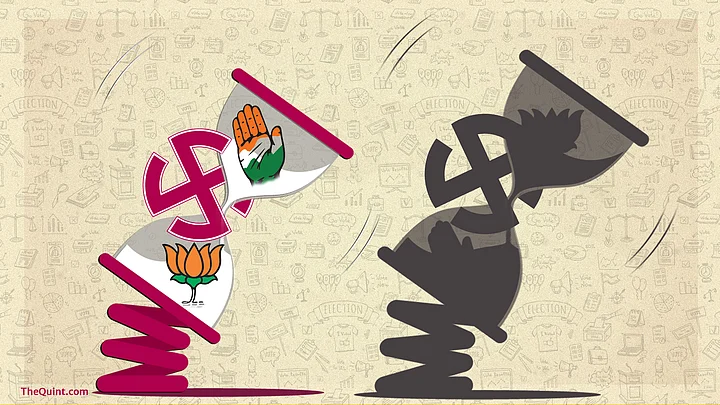An hour after sunset on 7 November 2015, a few hours before the results of the Bihar assembly elections were to be telecast, one of the most prominent leaders of the JD(U)-RJD-Congress grand alliance called a senior Delhi-based TV journalist, expressing his fears about what the outcome would be.
“He was very tensed and fumbled for words,” the journalist later said, sharing the leader’s sentiments of that evening.
Well, by the afternoon of 8 November 2015, the BJP was history in Bihar: the party, which had built up considerable noise that it would romp home with the electoral honours in the state, had been pulverised by the formidable mahagathbandan.
BJP For Win in UP?
The cacophony of an imminent BJP victory in Bihar was sought to be created by every means at the party’s disposal – favourable stories, an advertisement blitz, the landing of vocal party leaders in Patna, and of course, Amit Shah’s seeming exuberance in an interview to a TV channel. “Hum do-tihayi bahumat se jeet rahein hain,”(We shall win with two-third majority.) Shah had told the interviewer.
Today, as Prime Minister Narendra Modi feeds cattle in a Varanasi cowshed, bedecked in rudraksha maalas, visits the abode of Lord Vishwanath in Varanasi, a buzz has been created, much like it was done in the case of Bihar, that the BJP will come up trumps in Uttar Pradesh, India’s heartland.
This was the culmination of a well-orchestrated move to show an upper-hand in an otherwise keenly contested electoral battle. No sooner had the third and fourth phases of this spring’s staggered election ended, a perception has been created, seemingly with a view to influence public opinion.
An Action Replay of Bihar
It seems like it is an action replay of what happened in Bihar. After two phases of elections in Bihar, bookies had started placing bets on a mahagathbandhan’s win. Nitish-Lalu combine was expected to win 145 seats. After phase III, the mahagathbandhan’s tally dropped to 130 seats.
But there was a dramatic shift after that. While touring Bihar, we started receiving phone calls about how imminent polarisation in the rest of the two phases would work to the BJP’s advantages, and eventually propel the saffron party to pole position.
A report, in a leading Hindi daily on 3 November 2015, said: “Bookies who had placed bets on mahagathbandhan’s win after phase III, have revised their bets and are now backing the BJP-led NDA to get a majority.” Arguments backing such a dramatic turnaround ranged from imminent religious polarisation to the dream coalition of upper castes and extreme backward classes (EBC) falling in place.
A prominent national daily ran a series of stories on how there was an EBC surge for the BJP in pockets of Bihar. Reports of very well-attended rallies of the “charismatic and immensely popular” Prime Minister were used as additional proof to lend credibility to the change in position.
We attended such a rally near Patna after phase III. The attendance indeed was very impressive. But what we saw was a bit of an eye-opener. Even as the PM was delivering his speech, we saw hundreds of people streaming out of the venue, totally disappointed.
Some were not given return fare, some complained about not getting the promised jalebi-samosa, and some others said the promised wage never came their way. But such was the power of media blitz that we could never gather courage to make sense of what we saw.
The “Invincible Coalition of Upper Castes and EBCs”
Cut to Uttar Pradesh, and we witness a play-act all over again. A BJP leader called us after the elections in Western UP and said that phase I turned out to be disastrous. The report after phase II was that the BJP managed to recover some lost ground, but not enough to make a winning mark. But the moment the focus shifted to the eastern region, further away from Delhi, the entire narrative changed completely.
The same leader called after phase IV to inform us that “how a Modi wave is going to finish all opposition parties in the state.” He added that the “invincible coalition of upper castes and EBCs” indeed is becoming a reality.
So far, three prominent newspapers have run articles by influential columnists, proclaiming an outright BJP victory. This might as well be the outcome in an election, which by the end of the penultimate round (on 4 March), doesn’t appear to have a clear winner. The satta bazar numbers have wide variations. But they perceive the BJP to be getting close to a majority mark, which is quite a change from earlier projections.
The reporters, who were on the ground, reported voters’ unwillingness to express or share their preferences. There is no doubt about support for the BJP among social groups who have been its traditional voters, but there is an equal, if not greater, backing for the Samajwadi Party-Congress alliance among its own vote banks. The most under-estimated and enigmatic is Mayawati’s BSP.
In this melange of competing social claims and counter-claims, predicting or even hazarding a guess is fraught with risks.
However, what baffles us is the uncanny similarity in the grand narrative that panned out in Bihar during the course of a long election schedule, and how we are getting more of the same, albeit packaged differently, in the country’s most populous state.
Those who have been brave enough to call the UP election, need only read the first paragraph of Karl Marx’s ‘18th Brumaire of Louis Bonaparte’.
(At The Quint, we question everything. Play an active role in shaping our journalism by becoming a member today.)
